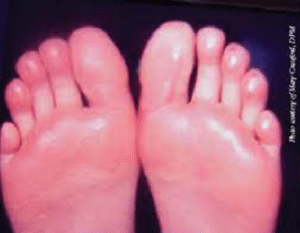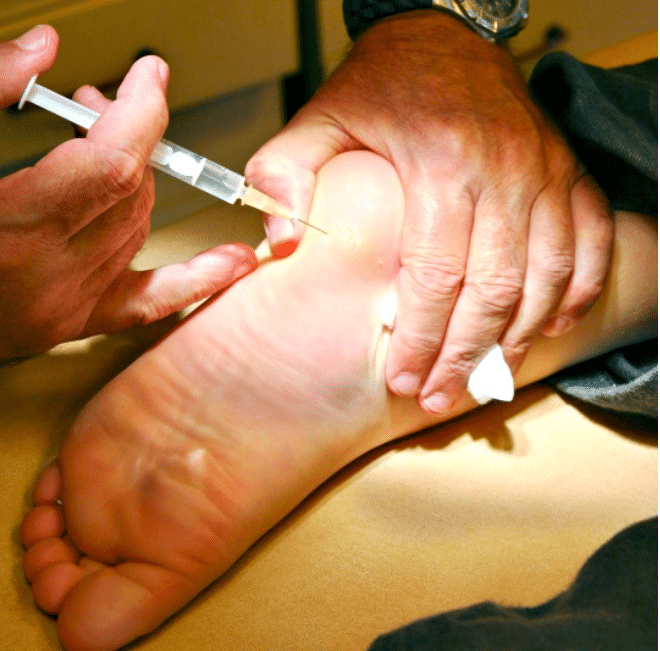Why People are Getting Botox in Their Feet
Attention media professionals and health enthusiasts! Are you tired of suffering from chronic foot and ankle pain? Are you looking for a groundbreaking solution to alleviate your discomfort and improve your quality of life? Look no further than our newest treatment of Botox in the foot and ankle!
According to a study published in the National Library of Medicine, administration of local injections of botulinum toxin (botox) was used to improve stance and gait and/or to facilitate physiotherapy and patient care. The results were promising.
That’s right, the same trusted formula used for years to smooth out wrinkles and treat other medical conditions is now being used to revolutionize foot and ankle care. Our innovative approach to pain management is safe, effective, and long-lasting, providing relief where other treatments have failed.
Our team of experts from Cutting Edge Foot and Ankle Clinic has spent years researching and perfecting this breakthrough technique, and we are thrilled to share our results with the world. By using targeted injections of Botox, we are able to relax overactive muscles and reduce inflammation in the foot and ankle, providing immediate relief and long-term benefits.
Whether you suffer from plantar fasciitis, Achilles tendonitis, or other common foot and ankle conditions, our Botox treatment may be the answer you’ve been looking for. And with minimal discomfort and downtime, you can get back to your daily activities without missing a beat.
According to another study, the most popular cosmetic operation in the United States is botulinum toxin injection for the treatment of facial wrinkles. It is also one of the most popular entrance procedures for practitioners looking to add aesthetic treatments to their practice. Small amounts of botulinum toxin injected into particular hyperactive muscles calm those muscles locally, smoothing the surrounding skin and minimizing wrinkles. The full effects of botulinum toxin take around two weeks to manifest and last for three to four months.

What is Foot Botox?
Although the botulinum toxin made the majority of its name and wealth in the cosmetics industry, it was originally utilized in medicine to help reduce fine lines long before it was given the go-ahead. It was initially developed to assist alleviate muscle spasms and straighten crossed eyes. This not only helps the face look more relaxed, but it also helps to prevent pain because nerves are unable to detect any discomfort. Additionally, Botox can aid in reducing excessive sweating, which means you won’t have to worry about slipping out of your leather sandals anymore.
The heel muscles receive the majority of the Botox injections since they experience the most pain when wearing tall shoes. By stopping their progression, Botox can also be used to treat calluses and bunions.
Why Are People Getting Botox in Their Feet?
These days, Botox serves more purposes than only treating facial wrinkles and fine lines. It’s also used to treat a variety of problems with other body parts, such as the foot.
Patients can treat common issues like foot discomfort and excessive sweating with Botox injections. This technique is popular since it is comparatively quick, straightforward, and requires little downtime.
1. Botox Prevents Foot Pain
Botox for foot pain may be an option to consider if you have a history of foot pain from bunions and edema. By lessening the activity of the nerve that transmits pain signals to the brain, it reduces discomfort. Botox for feet can also lessen sensitivity, which lessens pain and discomfort. Additionally, ladies who have bunions or calluses may use Botox to stop the worsening of these conditions, especially when wearing heels.
2. Botox Injections Alleviate Excessive Sweating
It can be annoying to have sweaty feet, which can lower your self-esteem and impact your daily life. However, Botox for sweaty feet provides a remedy by focusing on the underlying cause of excessive sweating—overactive sweat glands. The toxin efficiently lowers the amount of sweat generated by blocking the chemical impulses that activate these sweat glands. Overall, you can improve your quality of life, keep dry, and receive long-lasting comfort from this injection. This allows you to enjoy the summer, wear your beautiful shoes, and exercise without having to worry about having sweaty feet.
3. Botox Improves Plantar Fasciitis
Patients with plantar fasciitis may become completely disabled. However, new research has indicated that Botox for Plantar Fasciitis is a successful treatment for the ailment. It relieves pain by relaxing the painful tendons and muscles of the foot. The tension and irritation lessen when these muscles unwind. Patients have less cramping and pain reduction as a result.
How Long Does Foot Botox Last?
This effect lasts roughly four months and is comparable to botox for the face. However, receiving it frequently may result in the effects lasting longer between uses. When you can’t use your muscles because of botox, they get shorter and smaller since they aren’t being used. This implies that over time, you might require fewer botox treatments to achieve the same result.
What is the Feet Botox Procedure Like?
The botox technique for the feet is very similar to that for the face. The operation itself is brief and will be finished in a few minutes. The injections will be given straight into your feet, going after the source of the problem. Soon after your therapy, your foot discomfort may start to lessen. But in order to achieve the best results, it is advised to undergo a full course of treatments.
What Should I Expect After Foot Botox Treatment?
After your surgery, you ought to be able to return home right away. Typically, only minimal aftercare is required. For the next day or so, you can have some tenderness near the treated area. Once the Botox starts to take effect, your doctor will probably want you to check up in around 2 weeks after your session. For any missed locations, you could require a second operation.
What Are the Side Effects of Getting Botox For Foot Pain?
Chronic Migraines
Another typical side effect of Botox Cosmetic is headaches. It’s not quite understood what causes it, although it may be because the drug can make your muscles spasm before they become paralyzed. The good news is that headaches often last a few days and are not significant. If a headache is bothersome, over-the-counter drugs like naproxen or ibuprofen can assist.
Injection Site Reactions
The most frequent side effects of Botox Cosmetic are pain, bruising, and changes in the color of the skin at the injection site. These reactions typically occur after an injection momentarily damages a blood vessel. Reactions at the injection site are more likely to appear soon after your therapy and should disappear on their own. A less frequent injection-related side effect is a local bacterial infection. It’s possible for bacteria to enter your muscle when the needle punctures the skin. Making sure the injection site is clean prior to each dose is the best method to avoid this. Your Botox injection provider should take care of this as part of their normal preparation.
Dry Skin
Some patients may experience dry, flaky skin in the vicinity of their Botox Cosmetic injection sites. Although the exact reason why this occurs is unclear, it seems to be because Botox decreases the body’s ability to produce perspiration. The skin may become tighter and drier, with a flakier appearance.
Difficulty Swallowing or Breathing
The muscles in the mouth, throat, and neck that control breathing and swallowing can become weaker as a result of botox. For those who already struggle to breathe or swallow, this could be dangerous. These symptoms might emerge hours to weeks after a Botox treatment session, despite the fact that they are uncommon. After receiving an injection, if you experience trouble breathing or swallowing, get to the emergency department as soon as you can.
Nerve or Muscle Problems
People who already have nerve- or muscle-related issues, such as myasthenia gravis, should exercise caution when receiving Botox injections because they can result in muscle weakening. Botox might exacerbate your issue.
Is Foot Botox Worth it?
Patients can quickly resume their regular activities after receiving Botox injections. The results take 2 to 4 days to become apparent, and the injections take full effect after 2 weeks. Patients will eventually require further Botox injections because its effects are only transient.
Conclusion
Botox is used to treat a variety of problems with other body parts, such as the foot, and may be an option to consider if you have a history of foot pain. Botox injections can also be used to prevent excessive sweating by targeting the underlying cause of excessive sweating, which lowers the amount of sweat generated by blocking the chemical impulses that activate these sweat glands. This allows you to enjoy the summer, wear your beautiful shoes, and exercise without having to worry about having sweaty feet. The most important detail is that the botox technique for the feet is similar to that for the face, but the procedure lasts longer.
Don’t wait another day to take control of your foot and ankle health. Contact us today to learn more about our new Botox treatment and how it can change your life for the better. Let’s step into a brighter future together!
Would you be interested in diving deeper into learning more about the benefits of botox, or receiving expert commentary from a Cutting Edge physician? You may reach out to me by replying to this email. I’d be happy to coordinate an interview or answer any questions you may have.


